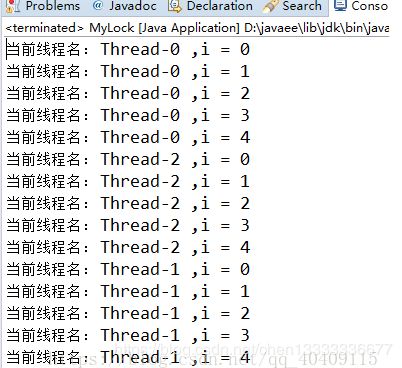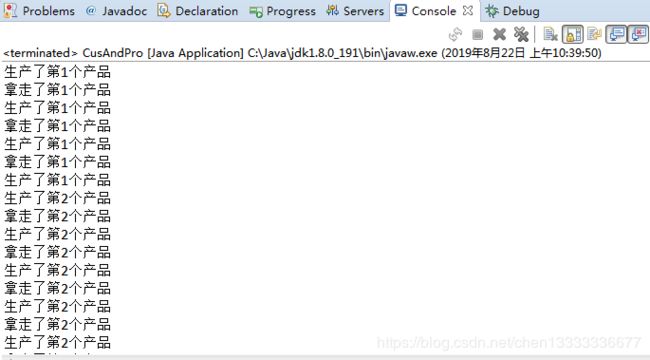Lock锁的使用
在Java多线程中,可以使用synchronized关键字实现线程之间的同步互斥,在jdk1.5后新增的ReentrantLock类同样可达到此效果,且在使用上比synchronized更加灵活。
观察ReentrantLock类可以发现其实现了Lock接口
public class ReentrantLock implements Lock,java.io.Serializable
1、使用ReentrantLock实现同步
lock()方法:上锁
unlock()方法:释放锁
/*
* 使用ReentrantLock类实现同步
* */
class MyReenrantLock implements Runnable{
//向上转型
private Lock lock = new ReentrantLock();
public void run() {
//上锁
lock.lock();
for(int i = 0; i < 5; i++) {
System.out.println("当前线程名: "+ Thread.currentThread().getName()+" ,i = "+i);
}
//释放锁
lock.unlock();
}
}
public class MyLock {
public static void main(String[] args) {
MyReenrantLock myReenrantLock = new MyReenrantLock();
Thread thread1 = new Thread(myReenrantLock);
Thread thread2 = new Thread(myReenrantLock);
Thread thread3 = new Thread(myReenrantLock);
thread1.start();
thread2.start();
thread3.start();
}
}

由此我们可以看出,只有当当前线程打印完毕后,其他的线程才可继续打印,线程打印的数据是分组打印,因为当前线程持有锁,但线程之间的打印顺序是随机的。
即调用lock.lock()代码的线程就持有了“对象监视器”,其他线程只有等待锁被释放再次争抢。
2、使用Condition实现等待/通知
synchronized关键字结合wait()和notify()及notifyAll()方法的使用可以实现线程的等待与通知模式。在使用notify()、notifyAll()方法进行通知时,被通知的线程是JVM随机选择的。
类ReentrantLock类同样可以实现该功能,需要借助Condition对象,可实现“选择性通知”。Condition类是jdk1.5提供的,且在一个Lock对象中可以创建多个Condition(对象监视器)实例。
/*
* 错误的使用Condition实现等待、通知
* */
class MyCondition implements Runnable{
private Lock lock = new ReentrantLock();
public Condition condition = lock.newCondition();
public void run() {
try {
System.out.println("当前线程名:"+Thread.currentThread().getName()+" 开始等待时间:"+System.currentTimeMillis());
//线程等待
condition.await();
System.out.println("我陷入了等待...");
} catch (InterruptedException e) {
e.printStackTrace();
}
}
}
public class MyLock{
public static void main(String[] args) {
MyCondition myCondition = new MyCondition();
Thread thread1 = new Thread(myCondition,"线程1");
thread1.start();
}
}

观察运行结果可以发现,报出监视器出错的异常,解决的办法是我们必须在condition.await()方法调用前用lock.lock()代码获得同步监视器。对上述代码做出如下修改:
/*
* 使用Condition实现等待
* */
class MyCondition implements Runnable{
private Lock lock = new ReentrantLock();
public Condition condition = lock.newCondition();
public void run() {
try {
//上锁
lock.lock();
System.out.println("当前线程名:"+Thread.currentThread().getName()+" 开始等待时间:"+System.currentTimeMillis());
//线程等待
condition.await();
System.out.println("我陷入了等待...");
} catch (InterruptedException e) {
e.printStackTrace();
}finally {
//释放锁
lock.unlock();
System.out.println("锁释放了!");
}
}
}
public class MyLock{
public static void main(String[] args) {
MyCondition myCondition = new MyCondition();
Thread thread1 = new Thread(myCondition,"线程1");
thread1.start();
}
}

在控制台只打印出一句,原因是调用了Condition对象的await()方法,是的当前执行任务的线程进入等待状态。
Condition类的signal():是当前执行任务的线程处于等待状态
/*
* 使用Condition实现等待、通知
* */
class MyCondition implements Runnable{
private Lock lock = new ReentrantLock();
public Condition condition = lock.newCondition();
public void run() {
try {
//上锁
lock.lock();
System.out.println(" 开始等待时间:"+System.currentTimeMillis());
System.out.println("我陷入了等待...");
//线程等待
condition.await();
//释放锁
lock.unlock();
System.out.println("锁释放了!");
} catch (InterruptedException e) {
e.printStackTrace();
}
}
//通知方法
public void signal(){
try {
lock.lock();
System.out.println("结束等待时间:"+System.currentTimeMillis());
//通知等待线程
condition.signal();
} finally {
lock.unlock();
}
}
}
public class MyLock{
public static void main(String[] args) throws InterruptedException {
MyCondition myCondition = new MyCondition();
Thread thread1 = new Thread(myCondition,"线程1");
thread1.start();
Thread.sleep(3000);
myCondition.signal();
}
}
可以得知:Object类中的wait()方法等同于Condition类中的await()方法。
Object类中的wait(long timeout)方法等同于Condition类中的await(long time,TimeUnit unit)方法。
Object类中的notify()方法等同于Condition类中的singal()方法。
Object类中的notifyAll()方法等同于Condition类中的singalAll()方法。
3、生产者消费者模式
package com.atguigu.java2;
import java.util.concurrent.locks.Condition;
import java.util.concurrent.locks.Lock;
import java.util.concurrent.locks.ReentrantLock;
/**
* 生产者(Productor)将产品交给店员(Clerk),而消费者(Customer)从店员处取走产品,
* 店员一次只能持有固定数量的产品(比如:20),如果生产者试图生产更多的产品,
* 店员会叫生产者停一下,如果店中有空位放产品了再通知生产者继续生产;如果店中没有产品了, 店员会告诉消费者等一下,如果店中有产品了再通知消费者来取走产品。
*
* @param args
*/
public class CusAndPro {
public static void main(String[] args) {
Clerk clerk = new Clerk();
Productor productor = new Productor(clerk);
Customer customer = new Customer(clerk);
Thread t1 = new Thread(customer);
Thread t2 = new Thread(productor);
t1.start();
t2.start();
}
}
class Clerk {
private int count = 0;
Lock lock = new ReentrantLock();// 获得锁
Condition condition = lock.newCondition();// 获得等待或者释放线程的类
// 生产产品
public void set() {
try {
lock.lock();
if (count >= 20) {
try {
condition.await();// 让线程处于等待状态
} catch (InterruptedException e) {
e.printStackTrace();
}
} else {
count++;
System.out.println("生产了第" + count + "个产品");
condition.signal();// 释放线程
}
} finally {
lock.unlock();
}
}
// 消费产品
public void get() {
try {
lock.lock();
if (count <= 0) {
try {
condition.await();// 让线程处于等待状态
} catch (InterruptedException e) {
e.printStackTrace();
}
} else {
System.out.println("拿走了第" + count + "个产品");
count--;
condition.signal();// 释放线程
}
} finally {
lock.unlock();
}
}
}
class Productor implements Runnable {
Clerk clerk;
public Productor(Clerk clerk) {
this.clerk = clerk;
}
@Override
public void run() {
while (true) {
try {
Thread.sleep(30);
} catch (InterruptedException e) {
e.printStackTrace();
}
clerk.set();
}
}
}
class Customer implements Runnable {
Clerk clerk;
public Customer(Clerk clerk) {
this.clerk = clerk;
}
@Override
public void run() {
while (true) {
try {
Thread.sleep(30);
} catch (InterruptedException e) {
e.printStackTrace();
}
clerk.get();
}
}
}
锁Lock分为“公平锁”和“非公平锁”。
公平锁:表示线程获取锁的顺序是按照线程加锁的顺序来的进行分配的,即先来先得FIFO先进先出顺序。
非公平锁:一种获取锁的抢占机制,是随机拿到锁的,和公平锁不一样的是先来的不一定先拿到锁,这个方式可能造成某些线程一直拿不到锁,结果就是不公平的·。
/*
* 公平锁
* */
class MyService{
private ReentrantLock lock;
public MyService(boolean isFair) {
super();
lock = new ReentrantLock(isFair);
}
public void serviceMethod() {
try {
lock.lock();
System.out.println("线程名:"+Thread.currentThread().getName()+"获得锁定");
} finally {
lock.unlock();
}
}
}
public class MyLock{
public static void main(String[] args) {
//设置当前为true公平锁
final MyService myService = new MyService(true);
Runnable runnable = new Runnable() {
public void run() {
System.out.println("线程名:"+Thread.currentThread().getName()+"运行了");
myService.serviceMethod();
}
};
Thread[] threads = new Thread[10];
for(int i = 0;i < 10; i++) {
threads[i] = new Thread(runnable);
}
for(int i = 0;i < 10; i++) {
threads[i].start();
}
}
}

由打印结果可以看出,基本呈现有序的状态,这就是公平锁的特点。
/*
* 非公平锁
* */
class MyService{
private ReentrantLock lock;
public MyService(boolean isFair) {
super();
lock = new ReentrantLock(isFair);
}
public void serviceMethod() {
try {
lock.lock();
System.out.println("线程名:"+Thread.currentThread().getName()+"获得锁定");
} finally {
lock.unlock();
}
}
}
public class MyLock{
public static void main(String[] args) {
//设置当前为true公平锁
final MyService myService = new MyService(false);
Runnable runnable = new Runnable() {
public void run() {
System.out.println("线程名:"+Thread.currentThread().getName()+"运行了");
myService.serviceMethod();
}
};
Thread[] threads = new Thread[10];
for(int i = 0;i < 10; i++) {
threads[i] = new Thread(runnable);
}
for(int i = 0;i < 10; i++) {
threads[i].start();
}
}
}

非公平锁的运行结果基本都是无须的,则可以表明先start()启动的线程并不一定先获得锁。
5、使用ReentrantReadWriteLock类
类ReentrantLock具有完全互斥排他的效果,即同一时间只有一个线程在执行ReentrantLock.lock()方法后的任务。这样虽然保证了实例变量的线程安全性,但是效率低下。所以在Java中提供有读写锁ReentrantReadWriteLock类,使其效率可以加快。在某些不需要操作实例变量的方法中,完全可以使用ReentrantReadWriteLock来提升该方法代码运行速度。
读写锁表示两个锁:
读操作相关的锁,也成为共享锁。
写操作相关的锁,也叫排他锁。
多个读锁之间不互斥,读锁与写锁互斥,多个写锁互斥。
在没有线程Thread进行写入操作时,进行读操作的多个Thread可以获取读锁,但是进行写入操作时的Thread只有获取写锁后才能进行写入操作。
(1)多个读锁共享
/*
* 多个读锁共享
* */
class MyService{
private ReentrantReadWriteLock lock = new ReentrantReadWriteLock();
public void read() {
try {
//读锁
lock.readLock().lock();
System.out.println("线程名: "+Thread.currentThread().getName()+"获取读锁" );
Thread.sleep(1000);
} catch (InterruptedException e) {
e.printStackTrace();
}finally {
//释放读锁
lock.readLock().unlock();
}
}
}
//线程1
class Thread1 extends Thread{
private MyService myService;
public Thread1(MyService myService) {
super();
this.myService = myService;
}
public void run() {
myService.read();
}
}
//线程2
class Thread2 extends Thread{
private MyService myService;
public Thread2(MyService myService) {
super();
this.myService = myService;
}
public void run() {
myService.read();
}
}
public class MyLock{
public static void main(String[] args) {
MyService myService = new MyService();
Thread1 thread1 = new Thread1(myService);
Thread2 thread2 = new Thread2(myService);
thread1.start();
thread2.start();
}
}

从打印结果可以看出,两个线程几乎同时进入lock()方法后面的代码。
说明在此时使用lock.readLock()读锁可以提高程序运行效率,允许多个线程同时执行lock()方法后的代码。
(2)多个写锁互斥
/*
* 多个写锁互斥
* */
class MyService{
private ReentrantReadWriteLock lock = new ReentrantReadWriteLock();
public void write() {
try {
//写锁
lock.writeLock().lock();
System.out.println("线程名: "+Thread.currentThread().getName()+"获取写锁,获得时间:"+System.currentTimeMillis() );
Thread.sleep(1000);
} catch (InterruptedException e) {
e.printStackTrace();
}finally {
//释放写锁
lock.writeLock().unlock();
}
}
}
//线程1
class Thread1 extends Thread{
private MyService myService;
public Thread1(MyService myService) {
super();
this.myService = myService;
}
public void run() {
myService.write();
}
}
//线程2
class Thread2 extends Thread{
private MyService myService;
public Thread2(MyService myService) {
super();
this.myService = myService;
}
public void run() {
myService.write();
}
}
public class MyLock{
public static void main(String[] args) {
MyService myService = new MyService();
Thread1 thread1 = new Thread1(myService);
Thread2 thread2 = new Thread2(myService);
thread1.start();
thread2.start();
}
}

使用写锁代码writeLock.lock()的效果就是同一时间只允许一个线程执行lock()方法后的代码。
(3)读写/写读互斥
/*
* 读写/写读互斥,
* */
class MyService{
private ReentrantReadWriteLock lock = new ReentrantReadWriteLock();
public void read() {
try {
//读锁
lock.readLock().lock();
System.out.println("线程名: "+Thread.currentThread().getName()+"获取读锁,获得时间:"+System.currentTimeMillis() );
Thread.sleep(1000);
} catch (InterruptedException e) {
e.printStackTrace();
}finally {
//释放读锁
lock.readLock().unlock();
}
}
public void write() {
try {
//写锁
lock.writeLock().lock();
System.out.println("线程名: "+Thread.currentThread().getName()+"获取写锁,获得时间:"+System.currentTimeMillis() );
Thread.sleep(1000);
} catch (InterruptedException e) {
e.printStackTrace();
}finally {
//释放写锁
lock.writeLock().unlock();
}
}
}
//线程1
class Thread1 extends Thread{
private MyService myService;
public Thread1(MyService myService) {
super();
this.myService = myService;
}
public void run() {
myService.read();
}
}
//线程2
class Thread2 extends Thread{
private MyService myService;
public Thread2(MyService myService) {
super();
this.myService = myService;
}
public void run() {
myService.write();
}
}
public class MyLock{
public static void main(String[] args) {
MyService myService = new MyService();
Thread1 thread1 = new Thread1(myService);
Thread2 thread2 = new Thread2(myService);
thread1.start();
thread2.start();
}
}
由此可表明:只要出现“写”操作,就是互斥的。


